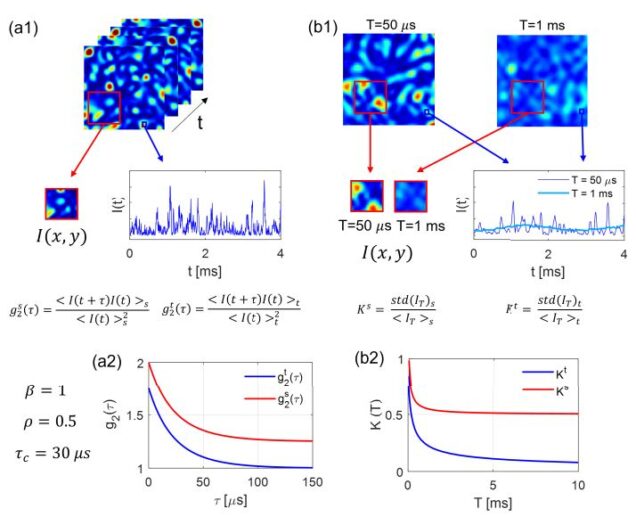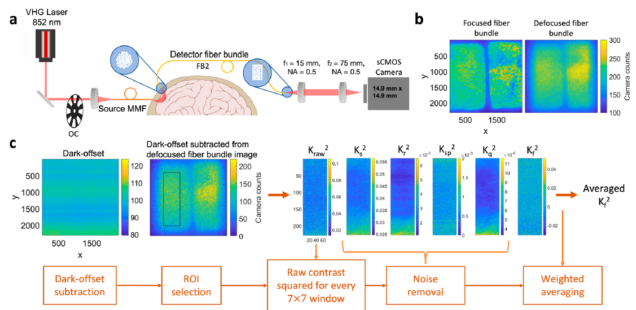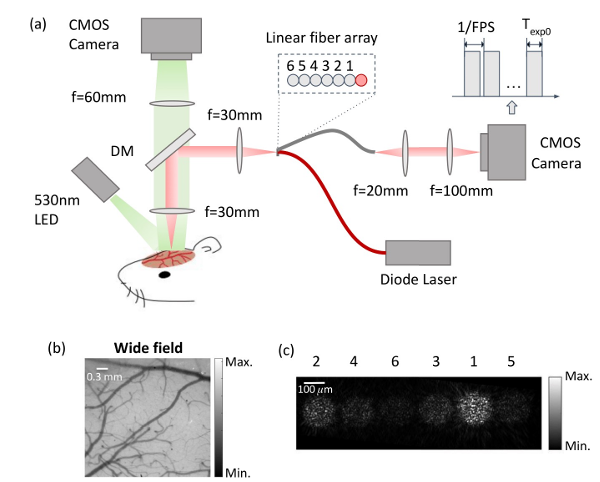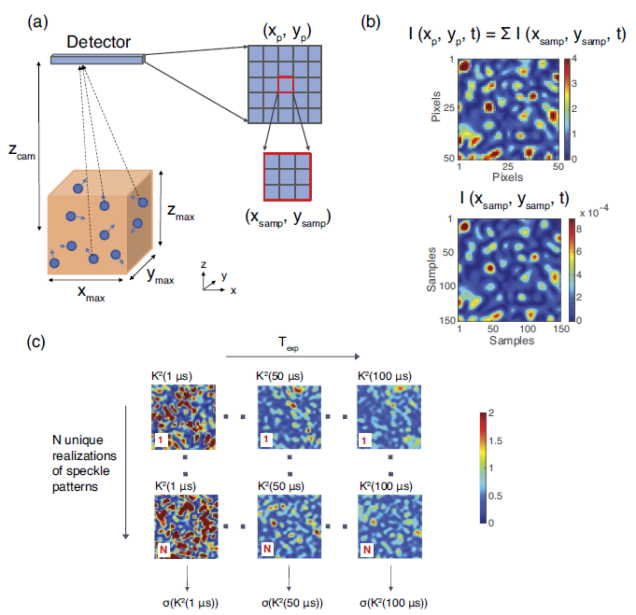Publications
Selected journal publications:
Bingxue Liu, Dmitry Postnov, David A. Boas, and Xiaojun Cheng, 2024. Dynamic light scattering and laser speckle contrast imaging of the brain: theory of the spatial and temporal statistics of speckle pattern evolution. Biomed. Opt. Express 15(2), 579-593.

Dynamic light scattering (DLS) and laser speckle contrast imaging (LSCI) are closely related techniques that exploit the statistics of speckle patterns which can be utilized to measure cerebral blood flow (CBF). Conventionally, the temporal speckle intensity auto-correlation function is calculated in DLS, while the spatial speckle contrast is calculated in LSCI measurements. Due to the rapid development of CMOS detection technology with increased camera frame rates while still maintaining a large number of pixels, the ensemble or spatial average of the auto-correlation functions as well as the temporal contrast can be easily calculated and utilized to quantify CBF. Although many models have been established, a proper summary is still lacking to fully characterize DLS and LSCI measurements for spatial and temporal statistics, laser coherence properties, various motion types, etc. As a result, there are many instances where theoretical models are misused. Therefore, we aim to provide a review of the speckle theory for both DLS and LSCI measurements with detailed derivations from first principles, taking into account non-ergodicity, spatial and temporal statistics of speckles, scatterer motion types, and laser coherence properties. From these calculations, we elaborate on the differences between spatial and temporal averaging for DLS and LSCI measurements that are typically ignored but can result in inaccurate measurements of blood flow. We also obtained in vivo mouse brain measurements using high frame rate CMOS cameras which have not been demonstrated before. This work provides a useful guide for choosing the correct model to analyze spatial and temporal speckle statistics in in vivo DLS and LSCI measurements.
Kim, B., Zilpelwar, S., Sie, E.J., Marsili, F., Zimmermann, B., Boas, D.A. and Cheng, X., 2023. Measuring human cerebral blood flow and brain function with fiber-based speckle contrast optical spectroscopy system. Communications Biology, 6, 844.

Cerebral blood flow (CBF) is crucial for brain health. Speckle contrast optical spectroscopy (SCOS) is a technique that has been recently developed to measure CBF, but the use of SCOS to measure human brain function at large source-detector separations with comparable or greater sensitivity to cerebral rather than extracerebral blood flow has not been demonstrated. We describe a fiber-based SCOS system capable of measuring human brain activation-induced CBF changes at 33 mm source-detector separations using CMOS detectors. The system implements a pulsing strategy to improve the photon flux and uses a data processing pipeline to improve measurement accuracy. We show that SCOS outperforms the current leading optical modality for measuring CBF, i.e. diffuse correlation spectroscopy (DCS), achieving more than 10x SNR improvement at a similar financial cost. Fiber-based SCOS provides an alternative approach to functional neuroimaging for cognitive neuroscience and health science applications.
Liu, B., Shah, S., Küreli, G., Devor, A., Boas, D.A. and Cheng, X., 2023. Measurements of slow tissue dynamics with short-separation speckle contrast optical spectroscopy. Biomedical Optics Express, 14(9), pp.4790-4799.

Laser speckle contrast imaging (LSCI) measures 2D maps of cerebral blood flow (CBF) in small animal brains such as mice.
The contrast measured in LSCI also includes the static and slow-varying components that contain information about brain tissue dynamics. But these components are less studied as compared to the fast dynamics of CBF. In traditional wide-field LSCI, the contrast measured in the tissue is largely contaminated by neighboring blood vessels, which reduces the sensitivity to these static and slow components. Our goal is to enhance the sensitivity of the contrast to static and slow tissue dynamics and test models to quantify the characteristics of these components. To achieve this, we have developed a short-separation speckle contrast optical spectroscopy (ss-SCOS) system by implementing point illumination and point detection using multi-mode fiber arrays to enhance the static and slow components in speckle contrast measurements as compared to traditional wide-field LSCI (WF-LSCI). We observed larger fractions of the static and slow components when measured in the tissue using ss-SCOS than in traditional LSCI for the same animal and region of interest. We have also established models to obtain the fractions of the static and slow components and quantify the decorrelation time constants of the intensity auto-correlation function for both fast blood flow and slower tissue dynamics.
Using ss-SCOS, we demonstrate the variations of fast and slow brain dynamics in animals before and post-stroke, as well as within an hour post-euthanasia. This technique establishes the foundation to measure brain tissue dynamics other than CBF such as intracellular motility.
Zilpelwar, S., Sie, E.J., Postnov, D., Chen, A.I., Zimmermann, B., Marsili, F., Boas, D.A. and Cheng, X., 2022. Model of dynamic speckle evolution for evaluating laser speckle contrast measurements of tissue dynamics. Biomedical Optics Express, 13(12), pp.6533-6549.

We introduce a dynamic speckle model (DSM) to simulate the temporal evolution of fully developed speckle patterns arising from the interference of scattered light reemitted from dynamic tissue. Using this numerical tool, the performance of laser speckle contrast imaging (LSCI) or speckle contrast optical spectroscopy (SCOS) systems which quantify tissue dynamics using the spatial contrast of the speckle patterns with a certain camera exposure time is evaluated. We have investigated noise sources arising from the fundamental speckle statistics due to the finite sampling of the speckle patterns as well as those induced by experimental measurement conditions including shot noise, camera dark, and read noise, and calibrated the parameters of an analytical noise model initially developed in the fundamental or shot noise regime that quantifies the performance of SCOS systems using the number of independent observables (NIO). Our analysis is particularly focused on the low photon flux regime relevant for human brain measurements, where the impact of shot noise and camera read noise can become significant. Our numerical model is also validated experimentally using a novel fiber-based SCOS (fb-SCOS) system for a dynamic sample. We have found that the signal-to-noise ratio (SNR) of fb-SCOS measurements plateaus at a camera exposure time which marks the regime where shot and fundamental noise dominate over camera read noise. For a fixed total measurement time, there exists an optimized camera exposure time if temporal averaging is utilized to improve SNR. For a certain camera exposure time, photon flux value, and camera noise properties, there exists an optimized speckle-to-pixel size ratio (s/p) at which SNR is maximized. Our work provides the design principles for any LSCI or SCOS systems given the detected photon flux and properties of the instruments, which will guide the way for the experimental development of a high-quality, low-cost fb-SCOS system that monitors human brain blood flow and functions in the future.